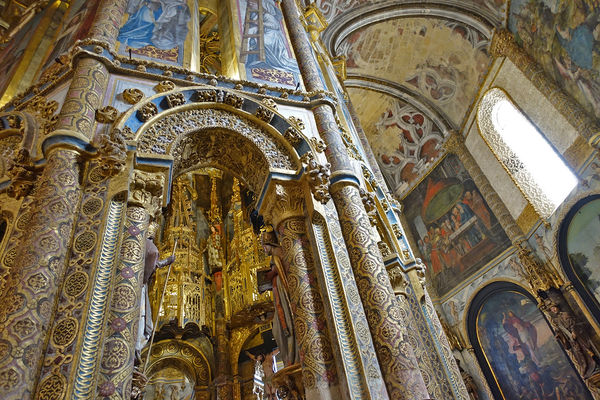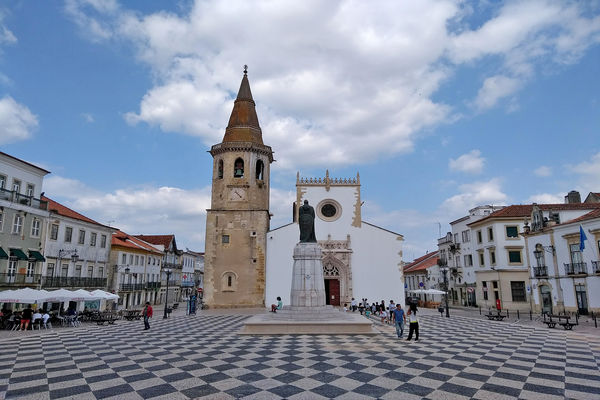Tranquil Tomar: A Break from Portugal’s Tourist Tumult
By Rick Steves

With a rich culture, friendly people, affordable prices, and a salty setting on the edge of Europe, Portugal understandably makes a rewarding destination for travelers. Bustling Lisbon and the sunny Algarve coast are well known to tourists (for good reason), but quieter places also offer tantalizing tastes of Portuguese flavor.
About 90 miles northeast of Lisbon, just east of the pilgrimage site of Fátima, is lushly green Tomar — a quaint town of about 20,000 residents, set under a historic fortress. It's a place with lots of local ambience, yet remarkably untouristed — and well worth a stop.
While there was a settlement here in Roman times, Tomar's importance started in the 12th century with the construction of a hill-topping castle, the Convento de Cristo. Gualdim Pais, a Grand Master of the Knights Templar religious order, put Tomar on the map by building the castle with Middle Eastern architectural techniques picked up during Crusades to the Holy Land.
To get the lay of the land, I strolled Tomar's riverside. The tiny Nabão River, running north-south through the middle of town, is all Tomar's — it starts nearby and flows just a few miles before emptying into the Tagus River outside of town. Mid-river, a peaceful island with a pleasant park and a rebuilt medieval waterwheel shows off what must have been impressive technology in its day. At the old bridge, Ponte Velha, I headed right through the old town to the main square, Praça da República. The town's easy-to-navigate grid is a reminder that Tomar was a garrison town built to defend the castle.
Praça da República is a tempting spot to slow down and nurse a drink at a café, enjoying the relaxed tempo of local life. Children on bikes test their training wheels, pigeons strut as if they own the place, old-timers shake their heads at today's fashions, and tuk-tuk drivers hustle business (negotiating short town tours on motorized rickshaws). The neighborhood offers plenty of inviting spots to grab a bite or a drink, such as the classic Café Paraíso, a time-warp eatery retaining the humble vibe of mid-century days.
Since Tomar is inland, pork and beef are staples on any menu here. All over town I noticed loaves of bread stacked into a very tall "crown," decorated with flowers. Women carry these on their heads in a festival every four years, incorporating pagan and harvest rituals into the Catholic celebration during the Festa dos Tabuleiros (Festival of the Trays) in late June or early July. Thanks to this tradition, expect fantastic bread with any meal here. Sip a glass of local Tejo wine or try a Portuguese craft beer as you take in the warmth and history right beside you.
Towering above Tomar is its castle, with an Oz-like oratory built 800 years ago. This circular chapel is where knights would go to be blessed before battle as they defended Portugal against the Moors, protected pilgrims heading for the Holy Land, or championed Portugal in the Age of Discovery. The Knights Templar was a rich organization — both as a popular Christian charity and as originator of Europe's first great banking system. Pilgrims from western Europe would deposit their money with the Templars before leaving home, were given a "check" (safer than cash to travel with), and could make withdrawals along their pilgrimage as they ventured east. You could call the Templars the first multinational corporation. When pilgrims died on their journey, which was all too common, the Templars kept their estate. (When banking, always read the fine print!)
The Convento de Cristo's interior gives a glimpse of the mystical wonder of the Knights Templar. The original castle and oratory were built when such impressive architecture was new in Europe. The oratory was designed so horses (important in the Templars' success on the battlefield) could be ridden in and blessed. Later, under Portuguese King Manuel I, a big conventional church was added. The oratory's wall was cut open to connect the church and the oratory with a grand, triumphal arch. The church's nave is decorated in the incredibly intricate Manueline style — motifs that pay tribute to the sea trade that made Portugal rich. Ornamental shields and coats of arms are decorated with castles, crosses, lions, flags, and crowns. There are even designs that duplicate ropes used on ships during Portugal's Age of Discovery.
Visiting this oratory, I was excited to realize I've been coming to Portugal all my life and I'd never been here before. That's good news — you can never exhaust Europe of its wonders.

